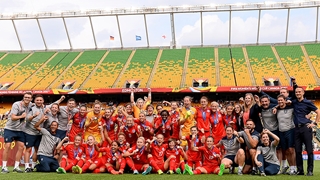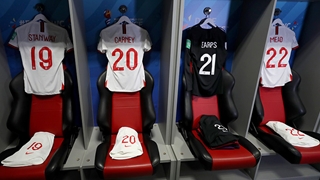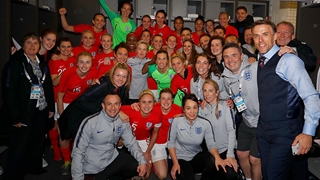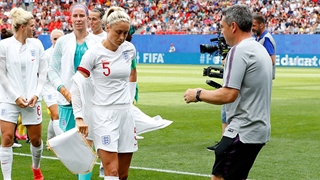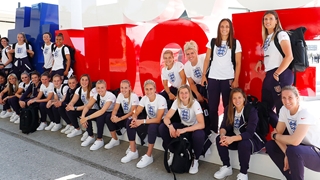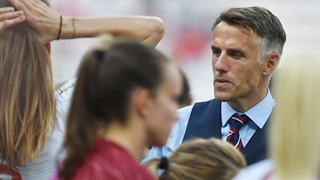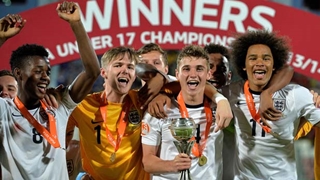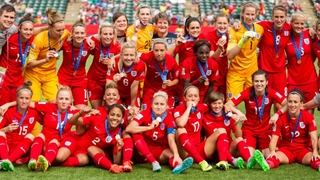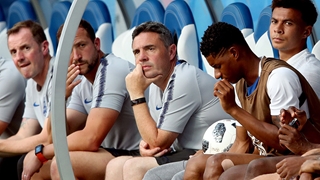
“I’m just a normal bloke from Stirchley and I’ve sat on the bench in three World Cup semi-finals.”
Meet Neil Jones, one of England’s loyal kit men who has worked with 11 different teams across the men’s and women’s games.
He was a key member of the backroom staff as the Men’s U17s won the Euros in 2014, followed quickly by a bronze medal at the Women’s World Cup a year later. He has also worked with the Men’s Senior side, alongside lead kit man Pat Frost, since the Nigeria game at Wembley in June 2018.
It is with the England Women’s team that Jones, 49, has the longest association, having started out with the Lionesses at the beginning of 2014. The recent World Cup in France was his last trip with Steph Houghton and co as his focus now shifts to helping Gareth Southgate prepare for the Euro 2020 qualifying campaign.
TICKETS: ENGLAND WOMEN v GERMANY
Neil, how long have you been an England kit man?
I started working with the England teams in 2010. I first got involved by delivering kit around Europe for the youth teams, but my first actual trip was with the England C team, who had a match against Poland in Poznan.
What is it like to be one of the England kit men?
You’re constantly pinching yourself. You almost can’t believe that you’re rubbing shoulders with some of the best players and coaches in the world.
Some of the coaches I’ve worked with were among my heroes growing up – probably none more so than Stuart Pearce.
As a fan, I used to watch Gareth Southgate and Phil Neville playing for England and here I am now working alongside them. It’s crazy really.
When I take a step back and think about it, I’m just a normal bloke from Stirchley and I’ve sat on the bench in three World Cup semi-finals. I’ve been incredibly lucky and I never take a single day for granted.
What are the highlights?
There have been quite a few over the years, but two really stand out – the Men’s U17 team winning the Euros and then the Women’s Senior team winning bronze in Canada the year after.
They were two very different, but absolutely fantastic achievements by each team and I’m really proud to have played a small part in each one. Those two tournaments will stay with me.
Where do you even start with packing all the kit? And how long does it take?
We take it camp-by-camp but it depends on whether we’re packing for a tournament or a one-off match or double header. But you’ve got to be organised either way; for the World Cup in France we started off with six tonnes of kit and equipment – that’s four van loads.
For a one-off camp we’ll pack four sets of training kit per player and staff member and two sets of match kit per player, per game. We obviously take spare kit with us and we do laundry every day to make sure everyone has enough kit to last them.
From start to finish it probably takes about seven days to pack for a tournament and for a one-off match it probably takes about six hours, including the time it takes to print the names and numbers on the shirts.
What are the challenges?
Missing my family is the main challenge, and I’m sure the players and the other staff members would say the same. We can be away from home for a long time over the course of a season so it’s only natural that I’m going to miss my wife and kids. In fact, I recently worked out that over the last five-and-a-half years, I’ve been away from home for two of them! The longest I was away for in one stint was seven weeks, for the World Cup in Canada.
But we face plenty of challenges while we’re on camp as well, with laundry cropping up more often than not. In 2015, I asked one of the hotels in Canada to wash all the kit and they somehow shrunk everything! I then had to try and iron out each individual piece of kit to try and stretch it as best I could.
Weather is another big challenge as you’ve got to pack for every eventuality. You’ve got to think of everything from caps and sweatbands to big coats and snoods. For example, in France this summer, it was 40 degrees in Lyon, but it was a lot colder in Le Havre so some players wanted to wear woolly hats for training. You’re always on your toes.
What has been the strangest request you’ve received from a player or manager?
We were staying in Larnaca for the Cyprus Cup in 2015 and Mark Sampson asked me to find an air horn from one of the local shops – on a Sunday! An air horn! He wanted to use it for training.
I thought I had no chance of finding one, but I somehow managed it. I stumbled across a scooter shop but because of the language barrier the shopkeeper was confused at first – so I had to make the noise of an air horn to help him understand! Remarkably, he had some old, dusty air horns out the back.
What about funny moments?
How long have you got?! There have been so many over the years – there is always something that will make you laugh on every trip.
Looking back, one of the funniest things actually happened on my very first trip, in Poznan. I was asked to fetch a crate of water just before kick-off. I was walking back to the bench, across the pitch, but because the sun was so bright I was a bit bleary eyed so I didn’t realise the teams had already come out of the tunnel. All of a sudden, our anthem starts playing so I just had to drop the water in the centre circle and bow my head – in front of 3,000 Polish fans! I was embarrassed at the time but looking back I suppose it was quite funny.
A similar thing happened in the World Cup quarter final in Canada – this time in front of 55,000 people! Thankfully I wasn’t on the pitch that time!
Is the kit room really the main social hub on camp?
Probably not so much ‘a hub’ these days but people do just wander in and have a chat with us. We had a sofa in the kit room in Russia so players and staff would use that if they didn’t want to be cooped up in their bedrooms or meeting rooms for too long.
Players know they can have a chat with me and Pat. We’re not judging them, we’re not picking the team, so maybe they can be themselves a bit more when they’re around us. There’s always a relaxed atmosphere in the kit room where people can just come in, sit down and have a chat.
The World Cup in France was your last tournament with the Lionesses. How do you reflect on the five years you spent with the team?
Working with the senior women’s team has changed my life, it genuinely has, and I’m really sad to be leaving them. I had the most unbelievable experiences working with that squad and I’ve seen some wonderful parts of the world, places I’d never have dreamt of visiting.
When I collect the players’ jackets after the national anthem (below), for what it’s worth, I like to wish each player good luck. The third-place play-off against Sweden was my last game with the girls and when I was collecting the jackets this time I could only say good luck to the first three players before I got choked up. I couldn’t speak. That’s when it hit me; I knew that was my 81st and final match with the senior women.
As it was my last tournament with them, I was asked to give a little speech later that night. I told the girls that I know it’s not a case of ‘if’ but ‘when’ they are going to win something. They are too good not to win something soon.
I’ll no longer be working with them, but I’ll be their biggest fan. It’s a really, really special group to be a part of.
Finally, Neil, what qualities does a good kit man need to have?
Good question; you’d better ask one!
First and foremost you've got to be organised. Very organised! I also think you also need to be co-operative, adaptable and patient. They’re probably the main attributes. I can’t wait for my family to read this…!


